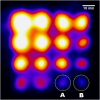Quantitative investigation of a novel small field of view hybrid gamma camera (HGC) capability for sentinel lymph node detection
- PMID: 27537079
- PMCID: PMC5124810
- DOI: 10.1259/bjr.20160435
Quantitative investigation of a novel small field of view hybrid gamma camera (HGC) capability for sentinel lymph node detection
Abstract
Objective: The hybrid gamma camera (HGC) has been developed to enhance the localization of radiopharmaceutical uptake in targeted tissues during surgical procedures such as sentinel lymph node (SLN) biopsy. To assess the capability of the HGC, a lymph node contrast (LNC) phantom was constructed to simulate medical scenarios of varying radioactivity concentrations and SLN size.
Methods: The phantom was constructed using two clear acrylic glass plates. The SLNs were simulated by circular wells of diameters ranging from 10 to 2.5 mm (16 wells in total) in 1 plate. The second plate contains four larger rectangular wells to simulate tissue background activity surrounding the SLNs. The activity used to simulate each SLN ranged between 4 and 0.025 MBq. The activity concentration ratio between the background and the activity injected in the SLNs was 1 : 10. The LNC phantom was placed at different depths of scattering material ranging between 5 and 40 mm. The collimator-to-source distance was 120 mm. Image acquisition times ranged from 60 to 240 s.
Results: Contrast-to-noise ratio analysis and full-width-at-half-maximum (FWHM) measurements of the simulated SLNs were carried out for the images obtained. Over the range of activities used, the HGC detected between 87.5 and 100% of the SLNs through 20 mm of scattering material and 75-93.75% of the SLNs through 40 mm of scattering material. The FWHM of the detected SLNs ranged between 11.93 and 14.70 mm.
Conclusion: The HGC is capable of detecting low accumulation of activity in small SLNs, indicating its usefulness as an intraoperative imaging system during surgical SLN procedures.
Advances in knowledge: This study investigates the capability of a novel small-field-of-view (SFOV) HGC to detect low activity uptake in small SLNs. The phantom and procedure described are inexpensive and could be easily replicated and applied to any SFOV camera, to provide a comparison between systems with clinically relevant results.
Figures







References
MeSH terms
Substances
LinkOut - more resources
Full Text Sources
Other Literature Sources

